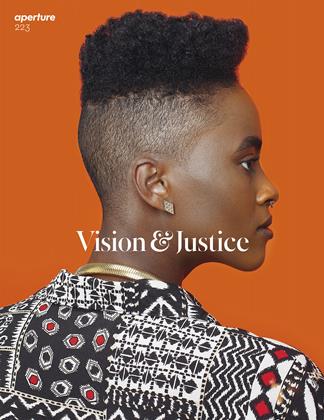Lyle Ashton Harris
Vince Aletti
From the beginning, Lyle Ashton Harris has been his own most reliable, malleable, and arresting subject. But his work is usually more about performance than self-portraiture: Harris is playing a role, often a dramatic and subversive one. He has photographed himself bare chested in whiteface; in full makeup as Billie Holiday and Josephine Baker; in gold-buttoned regalia as Toussaint L’Ouverture; and bloodied and sweating in a jockstrap as a boxer. He has played femme and butch, seductive and aggressive, pretty and potent. "I’ve always been interested in liminality,” Harris told Peter Halley in an interview for a self-titled 2014 catalog, "of being on the border of multiple crossover points, such as race, sexuality, and gender. And how does one engage that elasticity? ... For me it’s always been less about celebrating the notion of any type of homogenous queerness or blackness; it’s more about engaging the complexities at the edges of both.
In actuality, I’ve never really fit into any particular scene.”
So, in a sense, he created his own.
The portraits on these pages are among some two hundred Harris made in the decade following 1998 and published in his 2010 book Excessive Exposure. Starting with an already wide circle of friends, family, colleagues, and lovers, he opened up his project to members of the artistic, academic, and intellectual communities whom he’d engaged with or admired over the years. This new and pointedly diverse community (which includes Chuck Close, AI Sharpton,
Tony Kushner, Yoko Ono, Cindy Sherman, Wolfgang Tillmans, and this writer) sat for portraits in front of the imposing apparatus of a large-format, 20-by-24-inch Polaroid camera that Harris had rigged to take brown-toned images. The results subvert racial differences by rendering everyone in a range of chocolates, from milk to dark. Discussing the series with Chuck Close in Excessive Exposure,
Harris says the photographs remind him of nineteenth-century toned albumen prints, their timeless quality writ extra large. But, he adds with a laugh, "I think it’s a way of having my own little brown set of folks... I think people come in shades of brown, so I like it.”
"I’m attracted to my subjects in a lot of different ways,” Harris tells Close, "in relationship to form, to power, to desire, and in relationship to the transgression of class. For me, the process of portraiture is a way of negotiating intimacy.” But his presence here is not just implicit. Self-portraits open, close, and punctuate the book’s sequence of images, so he is also at the center of this expansive circle, with his studio a stand-in for its imagined common ground. "I began taking self-portraits in the 1980s to explore the dissonance and ambivalence I experienced in relation to my own image,” he says. He continued with the large-format Polaroid, but found the results "somewhat heavy” and difficult to deal with. Although he loved "the unforgiving detail that comes with the absence of intense highlights,” he had to admit "they’re not pretty pictures by any stretch of the imagination.” But prettiness has never interested Harris, so, once he toughed it out, he began inviting other people to submit themselves to the Polaroid’s steady, pitiless gaze.
The Chocolate Portraits he produced are penetrating but never unkind. Even when he’s shooting the backs of his sitters’ heads, Harris seems to comprehend them in full.
Vince Aletti reviews photography exhibitions for the New Yorker and photography books for Photograph, Artforum, and W.
PICTURES
 View Full Issue
View Full Issue
More From This Issue
-
 Pictures
PicturesJamel Shabazz
Summer 2016 By Khalil Gibran Muhammad -
 Pictures
PicturesLatoya Ruby Frazier
Summer 2016 By Teju Cole -
 Words
WordsBlack Lives, Silver Screen
Summer 2016 -
 Pictures
PicturesSally Mann
Summer 2016 By John Stauffer -
 Pictures
PicturesAwol Erizku
Summer 2016 By Steven Nelson -
 Pictures
PicturesDawoud Bey
Summer 2016 By Leigh Raiford
Subscribers can unlock every article Aperture has ever published Subscribe Now
Vince Aletti
-

Reviews
FALL 2024 By Michael Famighetti, Vince Aletti, Rebecca Bengal, 3 more ... -
 Pictures
PicturesMale ♂♀ Female
Summer 1999 By Vince Aletti -
 Books
BooksBob Richardson
Spring 2008 By Vince Aletti -
 Reviews
ReviewsCecil Beaton: The New York Years
Summer 2012 By Vince Aletti -
 Pictures
PicturesHervé Guibert
Winter 2014 By Vince Aletti -
 Pictures
PicturesTotal Records
Fall 2016 By Vince Aletti










